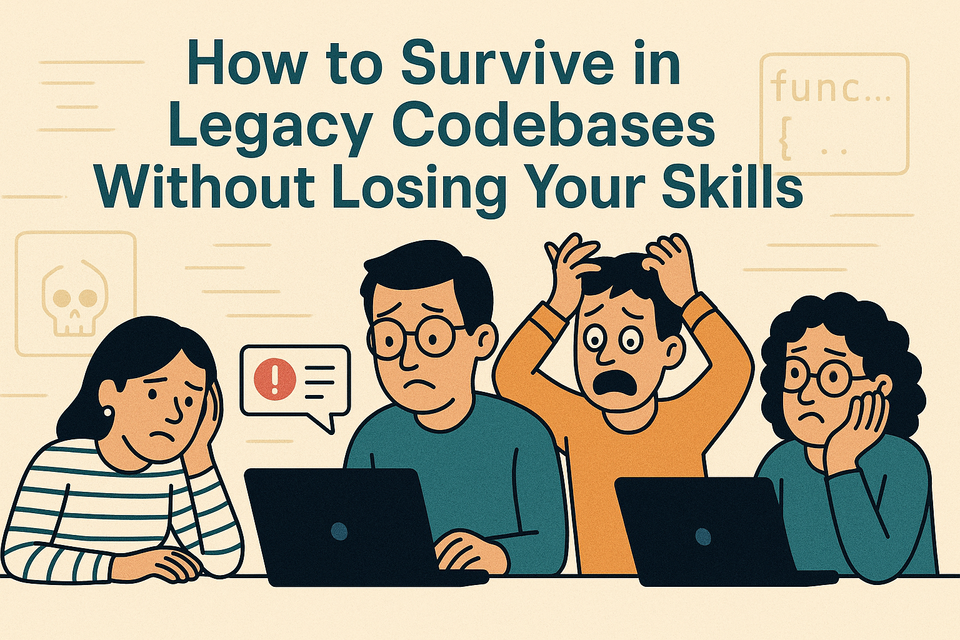How to Survive in Legacy Codebases Without Losing Your Skills

Working in a legacy codebase is like moving into a haunted house. At first, you think, “This can’t be that bad.” Then you open a closet and find a function written in 2004 that still controls your login flow. Suddenly, you’re dodging ghosts of past developers who thought global variables were a personality trait.
It’s not glamorous. It’s not greenfield. And if you’re not careful, it can eat away at your skills until you’re nothing more than a “bug patcher” who prays nothing new ever gets added. But it doesn’t have to be that way.
Here’s how to survive, and even thrive, when your day-to-day means wading through code older than some of your interns.
1. Stop Complaining, Start Cataloging
Yes, legacy code is bad. Yes, you’re not the first to notice. Complaining won’t fix it, and neither will pretending it’s fine. What you can do is start cataloging what you find. Keep a running list of “WTF moments,” spaghetti dependencies, and technical debt hotspots.
This isn’t just venting, it’s data. And data turns into refactor tickets, team discussions, and eventually, better systems. You might not get to fix it today, but you’re leaving breadcrumbs for yourself (and the poor soul who inherits this after you).
2. Treat Debugging as Training
Debugging legacy code is like weightlifting with bad form, you’re forced to stabilize muscles you didn’t even know you had.
Every time you track down a bug through three layers of nested XML configs, you’re building critical skills: pattern recognition, problem decomposition, and resilience. Don’t underestimate that. Greenfield devs may know the latest frameworks, but you’ll know how to solve problems when the docs don’t exist. That’s a superpower.
3. Add Guardrails Without Overhauling
You’re not going to rewrite the monolith this quarter, sorry. But you can add small guardrails: unit tests around scary functions, linting rules that stop new sins from being introduced, or even just better logging.
Think of it like putting child locks on a car you know isn’t safe, it won’t fix everything, but it’ll stop you from crashing immediately.
4. Keep Learning Outside the Day Job
Legacy code can stagnate you if you let it. Don’t. Spend time outside the trenches playing with modern tools and patterns. Build side projects, read blog posts, take courses. Bring that energy back into your legacy environment so when you do get the chance to modernize, you’re not suggesting practices from 2012.
Your career is bigger than this codebase. Don’t forget that.
5. Look for Opportunities to Refactor in Place
Not every refactor needs a six-month project plan. Sometimes you can improve things incrementally while you’re in the neighborhood. If you’re fixing a bug, maybe add a test. If you’re touching a method, maybe rename it to something sane. These tiny moves compound.
Legacy code doesn’t need a hero with a sword, it needs gardeners with pruning shears.
6. Find Humor in the Horror
You’ll find functions named things like doTheThing() or variables called temp2 that somehow control billing. Laugh at it. Make memes. Share inside jokes with your team. Humor keeps you sane, and sanity is a survival skill.
Final Thought: Legacy Code Is Part of the Job
Every company has skeletons in the closet. If you want to survive in tech long-term, you need to learn how to work with them without losing your spark. Legacy code may never make you fall in love with programming, but it can make you sharp, resilient, and resourceful.
And hey, someday, some junior dev will curse your name while fixing something you shipped. The circle of life continues.
👉 Over to you: What’s the wildest thing you’ve found in a legacy codebase?


Comments ()